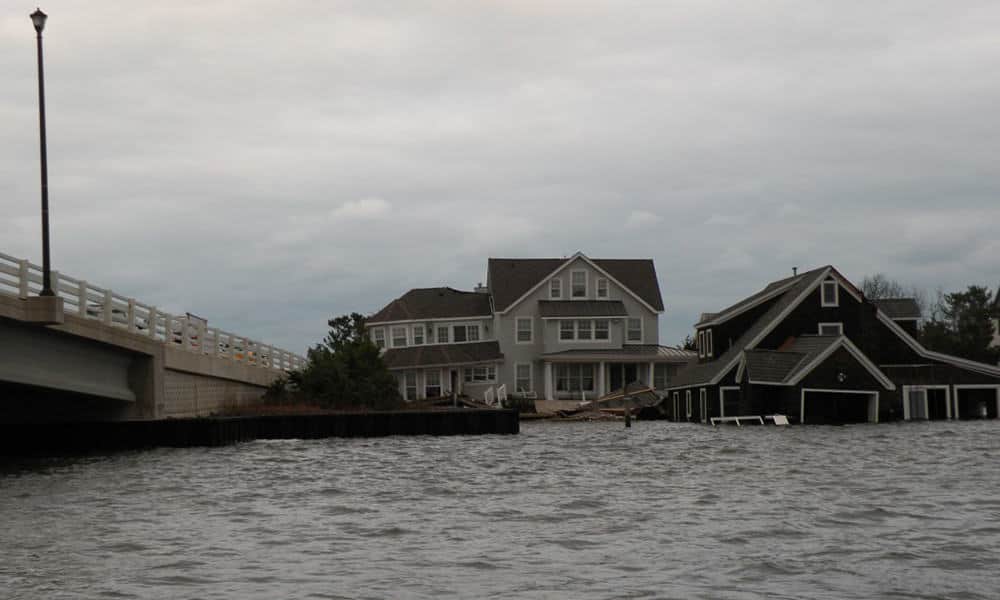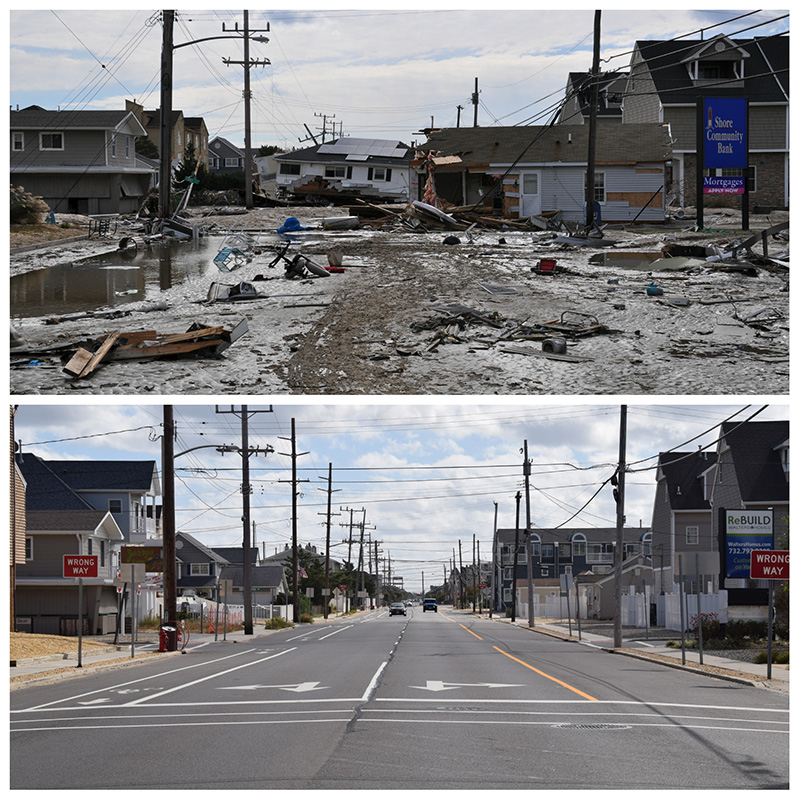
NEW JERSEY – Where were you this time, seven years ago? It might seem like an odd question, one which most people might not have answer to. However, if you visited or lived on the Jersey Shore in 2012, you can probably recall exactly where you were.
It was this time seven years ago that Superstorm Sandy slammed into the east coast with a truly fearsome force. Sandy made landfall in New Jersey on October 29, 2012. In the nine days that the storm ravaged the shore area, it took 147 American lives and caused at least $70 billion worth of damage.

National Geographic coined it a “raging freak of nature.”
“No one ever saw that coming or expected it to be what is was,” Dana Lancellotti, Director of Business Development and Tourism in Ocean County told Jersey Shore Online.
So how does a place come back from something like that? Well, according to Lancellotti, resilience is key.
Seven years later and the Jersey Shore has made a full recovery in many ways, boasting higher revenue from tourism and even better attractions that the ones that were taken down by Sandy.
Economy
In 2012, Ocean County brought in $4.291 billion, and in 2013, $4.191 billion from tourism.
It was thought that the summer of 2013, the first after Superstorm Sandy, would see much lower rates of visitors as they beaches were all but destroyed.
However, this was not the case.
Lancellotti noted that what kept Ocean County’s tourism revenue afloat was an influx of people traveling into the area to help with storm repair, such as the Army Corps of Engineers and the Federal Emergency Management Agency (FEMA).
While in the area, FEMA personnel, news reporters, and the like had to be put up in hotels and eat at local establishments, which in turn fed our economy.
So while tourists may not have been traveling to the Jersey Shore for a beach getaway in 2013, their presence was replaced by those flooding the area providing financial and structural support.
[adrotate banner="278"]While the figures for 2019 have not yet been calculated, Lancellotti noted that 2018 saw $4.785 billion from tourism in Ocean County.
“In the words of an anonymous boardwalk businessman, if you didn’t make money this past summer on the Boardwalk, you probably need to go find a 9-5 job,” stated Christopher Vaz, administrator for the Borough of Seaside Heights. “Great weather during the key months of July and August, with mostly sunshine on the weekends, combined with a strong economy added up to 2019 being considered one of the most successful tourism seasons in recent memory.”

“It [the comeback] was very fast considering what we were dealt,” Lancellotti added.
In fact, Ocean County never really saw too much of a dip in tourism revenue due to Sandy. From 2012 to 2018, the following figures represent how much revenue was brought in, as reported by New Jersey Tourism:
- 2012: $4.291 billion
- 2013: $4.191 billion
- 2014: $4.353 billion
- 2015: $4.557 billion
- 2016: $4.679 billion
- 2017: $4.775 billion
- 2018: $4.785 billion
It is evident that following 2013, there was a slow but steady increase in tourism to the area, culminating with an all-time high $4.8 billion in 2018. This pattern would suggest that 2019 saw an even higher amount.
As Lancellotti puts it: “Tourism is critical to the health and well-being of the people in Ocean County.”

And because of this, we had to be resilient.
Challenges
“In 2013 there were a lot of hiccups,” said Lancellotti, recalling a boardwalk in shambles and beaches that were all but washed away.
But this later became an opportunity to improve, implementing even bigger and better attractions, she said.
In order for the County to revitalize the shore both physically and financially, the boardwalk, dunes, beaches and even the fishing industry needed some attention.
Vaz reminded Jersey Shore Online that Seaside Heights in particular took a huge blow in two ways, Sandy in 2012 and then the boardwalk fire in September 2013.
“It took years for many businesses to rebuild, while others simply closed their doors…Casino Pier lost its upper deck…Funtown Pier, on the south end, was reduced to ashes,” said Vaz. “The perception in the minds of potential visitors was that Seaside Heights was closed for business. That perception lasted for a long time.”
Even now in 2019, things are not looking their best on the south end of the boardwalk.
“It does not appear that Funtown Pier will rise from the ashes,” Vaz added.
Vaz compared the loss of Funtown Pier to the loss of a major anchor store in a mall, such as Macy’s.
“The loss of our southern anchor “store” (which was actually an amusement pier and about 60 separate amusement-related businesses) has been difficult to overcome,” he said.
[adrotate banner="277"]But that is not to say that Seaside, as well as other shore towns, haven’t made great strides in replenishing their stores after the storm. For example, the recently completed beach nourishment and dune replenishment project has transformed local beaches something closer to what we remember pre-Sandy.

“For Seaside Heights the dune is a major change to our business operations and culture,” Vaz said.
Lancellotti added that the dune project did present its own set of challenges, however.
“Dunes change the landscape, obstruct the views in some cases,” she explained. “But they’re necessary.”
One thing that will never be quite the same: the local fishing industry. According to Lancellotti, the fishing industry took a major hit with Sandy, “and it was changed maybe permanently.”
Today, it remains a “vibrant” industry, “due to the very hard work of the fishermen themselves,” she explained, but it took a lot of marketing power to draw business back to local inlets such as the Viking Village in Barnegat Light.

Realizations
As Vaz puts it: “There is no viable Plan B for tourism when your roller coaster and other amusement rides are sitting on the bottom of the ocean.”
In other words, there is really no back up plan that will prevent a natural disaster like Superstorm Sandy from washing away that which makes a tourist destination thrive. One thing that Vaz and Lancellotti agree on is that all we can do is be knowledgeable and work hard to overcome it.
Lancellotti challenges local businesses that make their livelihood off of tourism to ask themselves: “What if that stopped?”
“They need to be proactive,” she said.
It wasn’t really until Sandy that the Ocean County Tourism Department really began marketing out of the normal realm. Once it was realized that the damage done by Sandy could mean much less newcomers and the loss of regular visitors, Lancellotti said that out-of-state marketing became of great importance.
Sandy has “shifted our goals,” she explained. “A piece of the discussion is always how to be better prepared.”
Through “hyper-targeted ads,” social media, commercials, and about 60,000 tourism magazines at drop locations along major thoroughfares like the Pennsylvania Turnpike and I-95, the Jersey Shore continues to market itself as the wonderful shore getaway it always has been.
Lancellotti is one of many who put in extraordinary hours marketing our area through travel expos and the like in order to let people know that Sandy didn’t take us down and perhaps recoup some of those former regular visitors.
“There are a lot of smart people who have done a lot of innovative planning,” she said.
Vaz continued, “Again, Sandy was an extraordinary storm. It is virtually impossible to implement any specific measures “to help keep tourism alive” in the context of the damage and destruction Sandy caused.
“You have to rebuild visitor confidence.”






